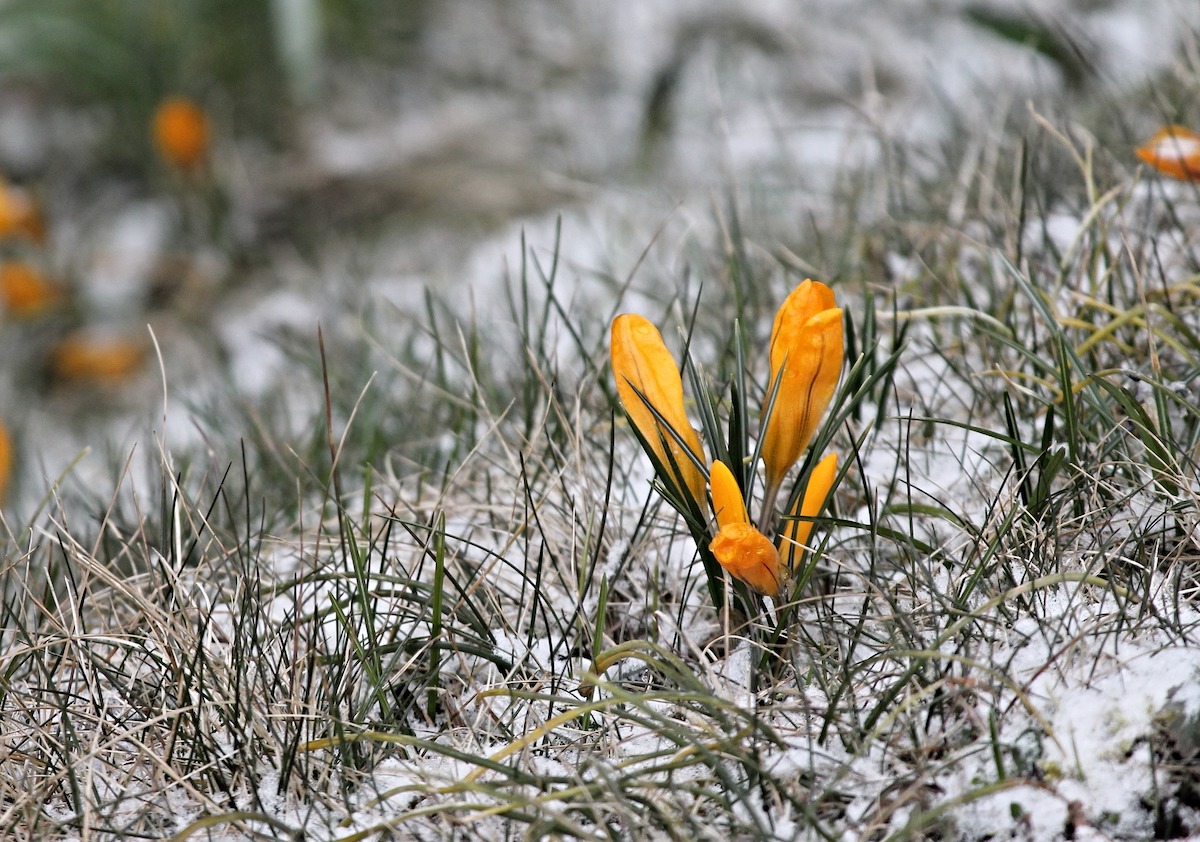
Not every plant in your yard needs to lose its petals and foliage when winter comes. Bright reds, soft pinks, sunny yellows –– these colors can still pepper your lawn, even when there’s snow. You just need hardy winter flowers that bloom in the cold.
Like viola, winter jasmine, and calendulas, many plants love cooler temperatures, and they don’t hesitate to take advantage of winter’s pollinators. Plants like black-eyed Susans and lavender won’t be making an appearance in winter. They prefer the warm weather of summer.
Now that you’ve winterized your lawn, your landscape needn’t look dreary, gray, and melancholy. Read on for a list of 20 best winter flowers that bloom in the cold and be sure to check out our section where we ask the experts.
Winter-Blooming Flowers and Ornamentals
Winter-Blooming Flowers and Ornamentals
Crocus
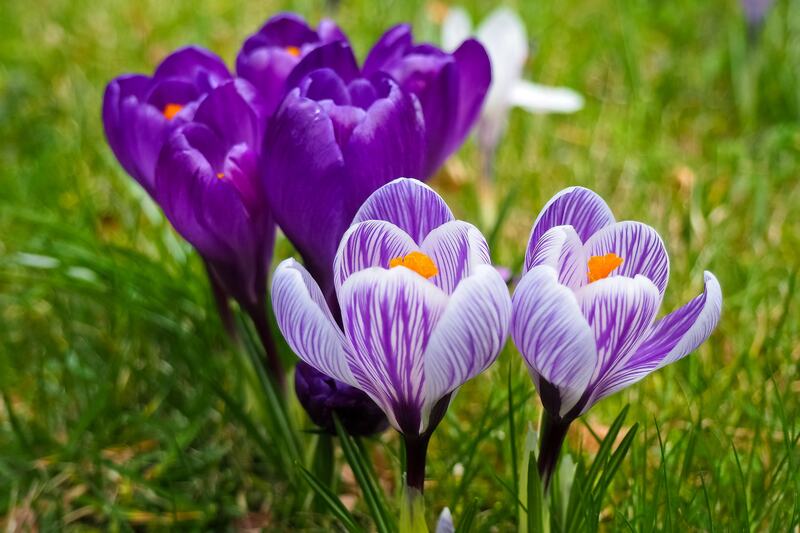
Common names: Crocus
Plant type: Perennial
Bloom time: Flowers appear in autumn, winter, or spring.
It’s normal to see these white, yellow, purple flowers peeping their tiny petals out of a cold snow. Crocuses have excellent cold-weather tolerance, and a chilly frost or snowfall likely won’t wipe them out.
Because they remain so close to the ground, the warm soil temperatures help protect these mighty flowers. The soil also ensures the underground bulb survives any freeze that does happen to kill the blooming crocus.
English Primrose
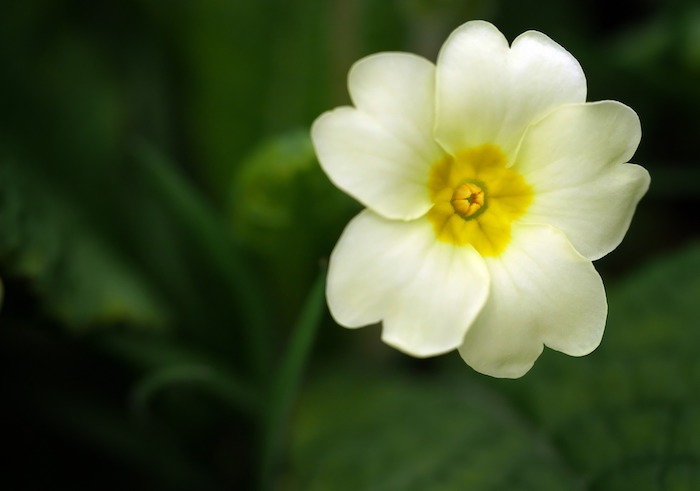
Common names: Primrose or common primrose
Lifespan: Perennial
Bloom time: Most primroses bloom in spring or summer, but English primrose makes its appearance in the winter months.
These lovely soft blooms can add a little sun to any cold, gray winter. They’re a comforting reminder that the nip of winter air will soon be over, and more vibrant blooms are yet to spring from the ground.
Viola
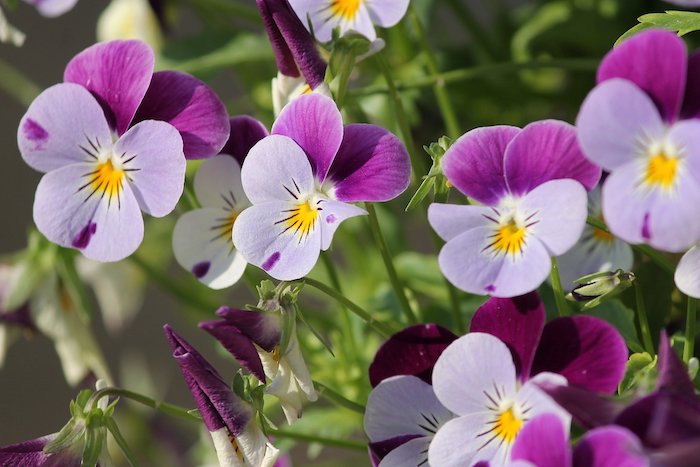
Common names: Pansies, johnny-jump-ups, or violets
Plant type: Annuals and perennials
Bloom time: Fall, winter, and spring
Violas bring a dazzling range of color to a barren, cold landscape changing with the seasons. Bold yellows, purples, pinks, oranges –– these pansies and violets will remind you of Alice’s Adventures in Wonderland.
These colorful flowers are also edible, making them excellent garnishes and scrumptious candies.
Snowdrop
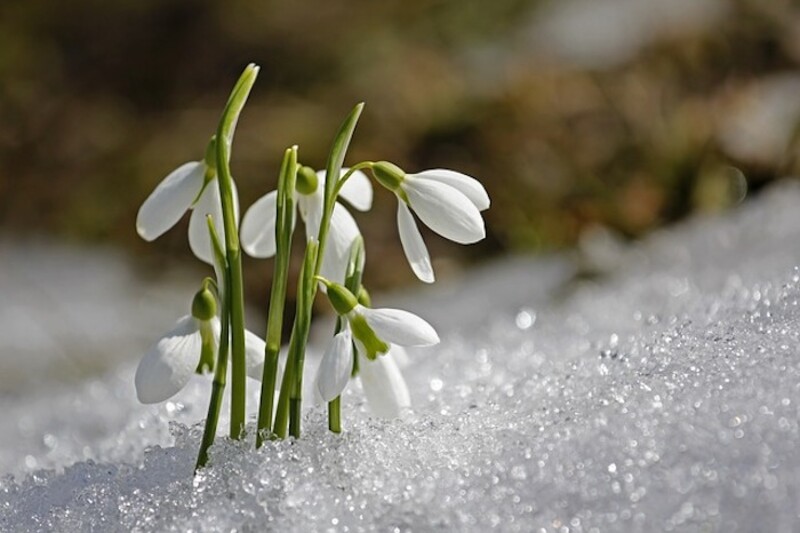
Common names: Galanthus
Plant type: Perennial
Bloom time: Fall, winter, and spring
An early sign of spring, snowdrops are typically the first among many winter bloomers to burst through the earth’s soil. These dainty flowers can make a striking, dense bloom that multiplies through the spreading of bulbs. Keep in mind that these plants are toxic to humans and pets.
Winter Aconite
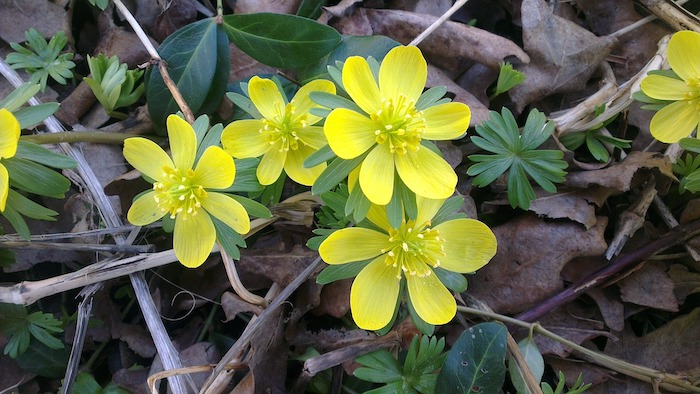
Common names: Winter aconite
Pant type: Perennial
Bloom time: Winter
Members of the buttercup family (Ranunculaceae), these tiny yellow spots will remind anyone with cabin-fever that warmer days are just ahead. Winter aconite love the warm sun so much, they only open when the sun is bright and shining.
On those dreary, overcast days, expect these little blossoms to close right on up. Though only 4 inches tall, they’ll sure make an impression on your landscape as they spread year after year.
Algerian Iris
Common names: Winter iris or Algerian winter iris
Plant type: Perennial
Bloom time: Fall, winter, and early spring
These lovely lilac-colored blooms will turn any gray, murky winter’s yard into a cozy, beautiful garden. Watch these plants shoot from their narrow grass mound and open into a breathtaking, delicate arrangement of soft petals. For a bouquet that brings life back into the freezing halls of your home, cut the Algerian iris’s stalk and feature the flower in your favorite vase.
Calendulas
Common names: Marigolds
Plant type: Although a perennial flower, it is typically treated as an annual due to its poor survival.
Bloom time: Fall, winter, and spring
These orange and yellow flowers will bring warmth and cheer to your wintery cottage garden. Though not frost tolerant, they begin to thrive as cooler temperatures arrive in autumn after a hot summer, and continue to bloom through winter and spring.
Calendula plants are sought after by gardeners due to their effect on pests. Aphids, whiteflies, thrips –– these pests will flock to your calendula and leave your valuable crops behind. These bright colored flowers also attract essential pollinators to your yard, including bees and butterflies.
Helleborus
Common names: Winter rose, Lenten rose, and Christmas rose
Plant type: Perennial
Bloom time: Winter and spring
If your shade garden is looking a little lonely in the wintertime, grow shade-loving helleborus (aka hellebores). These wintery blooms are long-lasting and fragrant and aren’t liked by deer and voles.
No need to worry about their little petals getting swallowed up and taken away from the beautiful winter view. Just don’t let your pets and small children eat these pretty flowers as the whole plant is poisonous.
Cyclamen
Common names: Sowbread, swinebread, Persian violet, or alpine violet
Plant type: Perennial
Bloom time: Fall, winter, and spring
These vibrant red and pink flowers are a real joy when flowers become a scarce delight in winter, and you can even enjoy them as houseplants. Their dainty blooms are under an inch tall and topped on long fragile stems.
Daffodils
Common names: Narcissus
Plant type: Perennial
Bloom time: Late winter to early spring
When these loud trumpets pop up from the icy snow, you know warmer temperatures are just on the horizon. These bright-colored flowers with their fun petal shapes put spring in all our minds as we scrape morning frost off the car or slip on an extra pair of wool socks.
A little daffodil springing from the wintery ground is enough to get you through a cold winter’s day.
Chionodoxa
Common names: Glory-of-the-snow
Plant type: Perennial
Bloom time: Early spring
Blue, pink, white, lavender –- these charming petite blooms will sprout from your garden year after year. Chionodoxa love to spread, so you’ll find new blossoms popping up the following growing seasons. To encourage spreading, leave these delicate flowers undisturbed. Less raking and weeding will ensure they multiply.
Chionodoxa is also resistant to those munching deer and has a high resistance to disease.
Ornamental Cabbage and Kale
Common names: Flowering cabbage and kale
Plant type: These vegetables are biennials, though they are treated as annuals. They grow their vegetative leaves the first year and then look like beautiful flowers the second year. The vegetables then produce seeds, die, and are removed from the garden.
Bloom time: Best to grow in spring or fall. Lasts through winter.
With their ruffled and textured leaves, these vegetables will look like giant flowers in your winter garden. They aren’t grown for their taste, but rather for their eye-popping, colorful effect on the landscape.
Ornamental cabbage and kale begin to color as temperatures drop, and will typically last through the winter if temperatures and weather are right. They won’t do well in harsh storms or hot sunny days, but they can withstand freezing temperatures.
Winter-Blooming Shrubs and Small Trees
Winter-Blooming Shrubs and Small Trees
Camellia
Common names: Sasanqua, japonica, or rose of winter
Plant type: Evergreen shrub or small tree
Bloom time: Sasanquas bloom from mid-fall to early winter. Japonicas bloom from mid-winter to mid-spring.
Camellias are renowned for their magnificent blooms. These evergreen shrubs feature thick, serrated, and glossy leaves throughout the year, and surprise us with their breathtaking flowers as temperatures drop. These stunning shrubs can grow between 6 to 15 feet tall, making them quite the spectacle in your white, winter wonderland.
Winter Jasmine
Common names: Winter jasmine
Plant type: Shrub
Bloom time: Winter
Beat the winter gloom with these budding shrubs. They burst with bright yellow sunshine in winter and are favored by gardeners for their low-maintenance care.
While most jasmine flowers feature beautiful scents, you won’t be smelling these winter jasmine any time soon. Unlike the rest of their family, winter jasmines aren’t fragrant flowers.
Higan Cherry
Common names: Rosebud cherry, spring cherry, winter-flowering cherry, weeping Higan cherry
Plant type: Cherry tree
Bloom time: Late winter to early spring
Higan cherry trees add a lovely, charming spot of color during a frigid winter. Admire their soft pink petals contrasting against the tree’s dark bark and look forward to their full flowering in the spring. Nothing quite compares to the miraculous blooms of cherry blossoms to transition us from a long winter to sunnier spring days.
Winterberry
Common names: Black alder, Canada holly, coralberry, winterberry holly, Michigan holly, fever bush, winter hollyberry, hollyberry, false alder, and fever bush
Plant type: Deciduous holly
Bloom time: Both the male and female plants bloom small, white flowers in summer. The female produces bright red berries in summer, lasting through winter.
For a splash of striking red against a white snow blanket, consider growing winterberries. These hollies are dioecious, which means they need a male and female plant to grow within 50 feet of each other to produce their wintery red berries. But it’s the female, not the male, that has the berries.
These stunning clusters of speckled scarlet berries will arrive in summer and last through winter, depending on how quickly the birds feast on the berries. Some hollies may lose their berries by early winter to the birds, while others may have a longer winter showing. Needless to say, winterberry holly is a perfect addition to the winter wildlife habitat in your lawn.
Witch Hazel
Common names: Witch hazel
Plant type: Deciduous shrub or small tree
Bloom time: Fall, winter, and spring
Witch hazel is popular for its low-maintenance care, attractively textured blooms, medicinal and cosmetic properties, and high resistance to pests and disease. Its sweet fragrance cuts through the crisp cold air, giving your nose quite the delight as you step outdoors.
Boxwood
Common names: Box plant
Plant type: Evergreen shrub or small tree
Bloom time: Spring
These boxwood shrubs aren’t exactly celebrated for their spring blooms, which are small, yellowish-green, and produce seeds for reproduction.
What makes evergreen boxwoods so prevalent in winter is their dark green foliage and beautiful texture bringing life to a lonely and empty winter landscape. They are exceptionally eye-catching just after a snowfall when the soft snow shines white against the deep green leaves.
Boxwoods can also be trimmed and cut into just about any shape or size, making them a stunning, art-like focal point in the yard.
Pussy Willow
Common names: Pussy willow
Plant type: Deciduous shrubs or small trees
Bloom time: End of winter through spring
The soft tufts growing along your pussy willow may not look like flowers at all, and they indeed don’t have bright colors or a beautiful scent. But these little fuzzy nubs are flowers just before they fully bloom.
The nubs, famous for their cat paw resemblance, signal that warm spring weather is just around the corner. Once spring rolls around, the pussy willow enters full bloom and creates petalless flowers called catkins.
As they bring us closer to spring and feel soft against our frozen fingertips, pussy willows also make for great seasonal decoration. Snip a few of the fuzziest branches, place them in a vase inside, and you may even get to see them bloom.
Mahonia
Common names: Mahonia
Plant type: Evergreen shrub
Bloom time: Winter and spring
This evergreen shrub will burst with bright yellow flowers, renewing your landscape and bringing joy to the changing seasons.
Winter can be a dreaded, lonesome season for many, but with a fabulous explosion of yellow contrasted against dark green leaves and white snow, you won’t be in much of a hurry for summer to get here.
Stop to Smell the Winter Flowers
There’s no need to let the joys of sunny weather and beautiful gardens escape in winter. Gray landscapes, bare trees, and the frozen earth shouldn’t have to take the spring out of your step.
Admire the gorgeous camellia hanging by the porch, gaze at your flowering Higan cherry, and laugh at the birds fighting over the scarlet winterberry.
Ask The Experts
- How can gardeners keep their winter-blooming flowers alive during the cold winter?
- How can gardeners keep houseplants alive in the winter?
- What is your favorite flower to grow outdoors in the winter? What makes it your favorite?
- What is your favorite houseplant to grow in winter? What makes it your favorite?



What is your favorite flower to grow outdoors in the winter? What makes it your favorite?
I read the article you posted. I love hellebores, but you already have them listed. I can answer this question with Hellebores, but my preference is a plant that is not listed. So here’s my response to the question using my actual favorite winter flower.
Hands down, one of my favorite winter plants for any winter garden is Edgeworthia chrysantha, commonly known as the paperbush plant. This shrub grows well in zones 7-10 and provides lovely fall and winter interest.
Part of what I enjoy about this plant is its architectural interest — in the winter, the plant has no leaves, but in December forms clusters of beautiful yellow blooms that are tiny, but sweetly fragrant.
In the spring, after the blooms pass, the foliage is lush and bluish-green with silvery undertones. This plant is ideal for gardens of any kind as it is resistant to insects and diseases and attracts pollinators of all kinds. More information on this wonderful winter plant can be found here.

1. How can gardeners keep their winter-blooming flowers alive during the cold winter?
Plants have a multitude of ways to manage cold weather. Plants that flower during cold weather (such as many witch hazel varieties) will often open and close their flowers based on the cold to prevent damage to reproductive parts. Plants such as crocus, daffodils (Narcissus spp.), and Lenten rose (Helleborus spp.) often do something similar.
Pansies (Viola spp.) are very cold tolerant and do very well in cold temperatures. For those evenings when extreme cold temperatures are expected, the gardener can cover their pansies with a small layer of straw.
Magnolia flowers will often succumb to cold temperatures and there is little gardeners can do, except hope for better weather next season. Generally, it’s best to let Mother Nature take her course.
2. How can gardeners keep houseplants alive in the winter?
Houseplants can be brought inside during autumn and placed in a sunny window, watering as needed until they can be placed outdoors again in late spring or early summer.
3. What is your favorite flower to grow outdoors in the winter? What makes it your favorite?
One of my favorites are the hybrid and vernal witch hazel. There are many different cultivars out there, and most flower between Feb. to March, depending on the winter season.
They are available in shades of yellow, orange, red, and purple. Most witch hazel have an amazing scent as well.
They are tough, durable, medium-sized shrubs with early flowering, clean summer foliage, and excellent fall color. What’s not to love?
4. What is your favorite houseplant to grow in winter? What makes it your favorite?
I have approximately 40 different houseplants, so picking a favorite is hard. I love the philodendrons for their ease of care, zebra plant for the colorful purple foliage, and snake plant for the fact that I don’t have to remember to water them all the time.
Spider plants make great hanging baskets, and ZZ plant is unusual-looking, while also being very simple to grow. There are so many to choose from.
FAQ
Local wildlife needs the same elements for survival that humans do:
● Food: Calendula and winterberry holly attract bees, butterflies, and birds to your winter buffet. Other helpful winter food supplements include suet hangers and bird feeders filled with peanuts and bird seed blends. (Yes, the squirrels will also eat from the bird feeders.)
● Shelter: Man-made birdhouses are an obvious choice for our avian friends, but did you know that plants are your best bet? Shrubs, native plants, mature trees, burrows, and brush piles all provide shelter for wildlife over the winter.
● Water: A heated bird bath may be necessary for climates with below-freezing winter temps. In areas with mild winters, an unheated bird bath will remain unfrozen on all but the coldest days.
Here are a few tips on how to winterize your lawn before the first draft of snow this winter:
● Mow the leaves.
That’s right. Even though your lawn has slowed to a crawl, you probably have leaves that fall daily. Keep up your weekly (or twice-weekly) mowing routine and mulch those leaves. Finely mulched leaves are a source of nutrition and add organic matter to your soil. You can mulch-mow the leaves if there is less than 50% leaf coverage on the lawn. At 50% coverage or below, dry, finely mulched leaves shouldn’t harm your lawn.
● Bring out the rake (or mow and bag).
Let’s face it, sometimes (especially in the fall), it’s tempting to slow down and not mow the lawn as often. If more than half of the lawn is covered in leaves, it’s time to bring out the rake or bag the leaves as you mow.
After you’re done, don’t even think about putting them in a garbage bag! Dump them into the compost pile or put them in your city’s green waste bin.
● Perform cool-season lawn chores.
Fall is the time to fertilize, overseed, and aerate cool-season lawns. Fall is a period of active growth for cool-season grass types, so now is the time to perform these lawn chores.
Get your garden ready for spring with these tips on how to winterize your garden:
● Dig up annuals.
Summer annuals delight us with their blooms all summer long, but their beauty is short-lived, and it’s time to get ready for spring. Remove annual flowers and vegetables from the garden and flower beds. Leaving them in the ground over the winter only invites diseases and pests.
● Bring tender plants indoors.
Some perennials can’t take the cold, but they do just fine overwintering in a sunny spot in your home. Bring frost-sensitive bulbs and succulents indoors to wait out the winter temps inside.
● Use a frost cover in your garden.
Set up row covers to protect winter vegetables and shrubs from snow and heavy frost. Wait until freezing temps or snowy weather hits to put on the coverings, though. Take them off during the day or when temps warm up again to maximize sunlight exposure and prevent the plants from getting too warm. Many winter vegetables taste sweeter when exposed to light frost.
When to Call a Landscaping Professional
Call a professional landscaper near you if you need assistance with landscape design, installation, or maintenance.
When you want the perfect wintery landscape in your backyard, sometimes you need the advice of a professional. A landscaper can help choose flower arrangements that best accentuate your yard, and they can determine where these flowers will flourish.
When it’s cold outside, and the chilly wind is nipping your dry fingers, a lawn care professional can help maintain your winter flowers for you so you can stay inside where it’s warm and enjoy a hot chocolate.
Main Image Credit: Pixabay